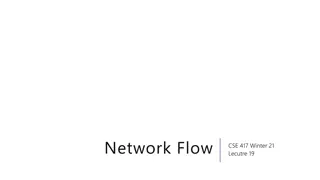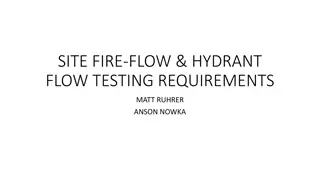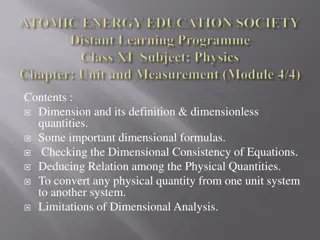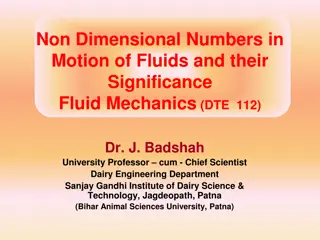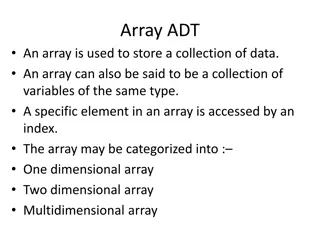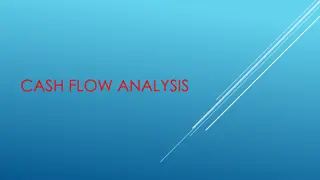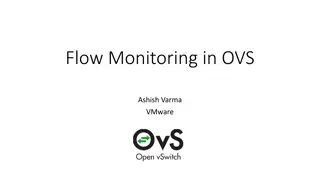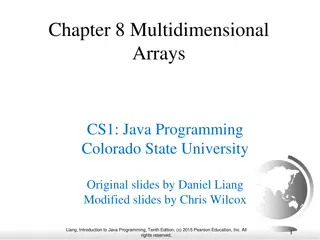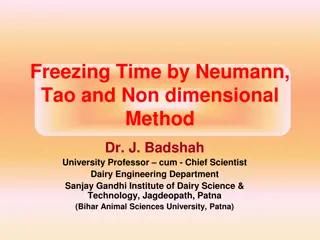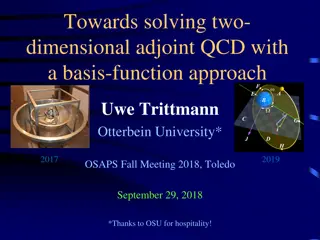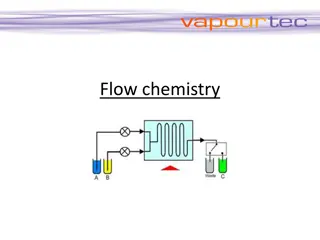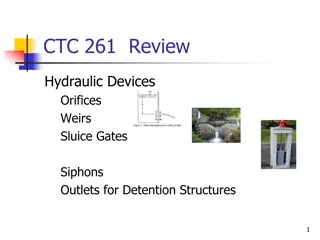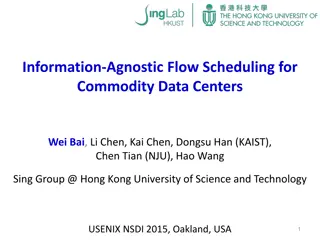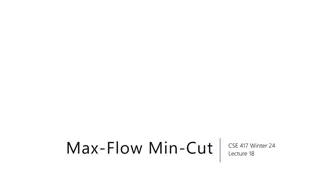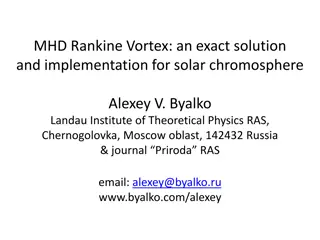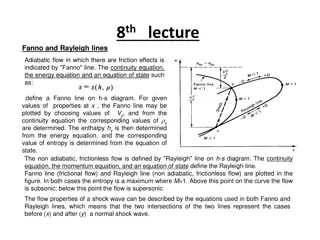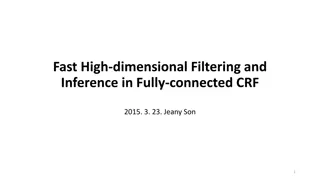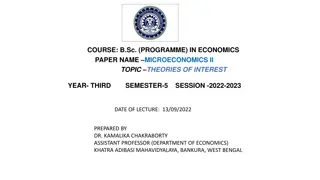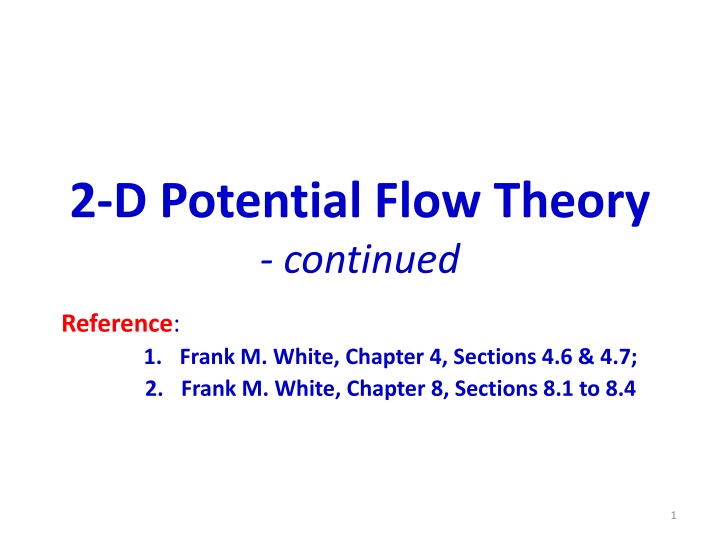
Understanding Potential Flow Theory in Fluid Dynamics
Dive into the realm of potential flow theory in fluid dynamics as we explore the concepts, equations, and applications related to inviscid, incompressible, irrotational, and steady flows. Discover the principles behind solving potential flow problems and how they apply to aerodynamics and aircraft movement.
Download Presentation

Please find below an Image/Link to download the presentation.
The content on the website is provided AS IS for your information and personal use only. It may not be sold, licensed, or shared on other websites without obtaining consent from the author. If you encounter any issues during the download, it is possible that the publisher has removed the file from their server.
You are allowed to download the files provided on this website for personal or commercial use, subject to the condition that they are used lawfully. All files are the property of their respective owners.
The content on the website is provided AS IS for your information and personal use only. It may not be sold, licensed, or shared on other websites without obtaining consent from the author.
E N D
Presentation Transcript
2-D Potential Flow Theory - continued Reference: 1. Frank M. White, Chapter 4, Sections 4.6 & 4.7; 2. Frank M. White, Chapter 8, Sections 8.1 to 8.4 1
2-D Potential Flow Theory . 1. Introduction, def., some basic concepts 2. General governing Eqns; reduced forms, 3. Solving the Potential Flow Velocity potential function, Laplace eqn Stream function, Laplace eqn Superposition of elementary potential flow models; Examples: Uniform Flow and Source Flow Uniform Flow and Source / Sink Pair:The Rankine Oval Uniform Flow and Doublet: Non-lifting flow over a circular cylinder Uniform Flow, Doublet and Free Vortex: Lifting flow over a circular cylinder 4. Conclusion : The Kutta Joukowski Thm 2
2-D Potential Flow Theory Potential flow is an inviscid, incompressible, irrotational, steady flow Potential Flow Theory is a mathematical method developed to solve flow problems that can be closely approximated as a potential flow 3
2-D Potential Flow Theory Question What do we mean by solve ? 4
Consider an air craft moving in air: air body Questions? Why doesn't it fall down ? (What keeps it floating in air? Why/How does it move forward? 5
Known: The forces exerted on bodies moving through a fluid are caused only by two reasons: 1. Pressure distribution ( p ) over the body surface, 2. Shear-stress distribution ( ) over the body surface. i.e., pressure and Shear-stress are the only two mechanisms nature has for communication of force & moment between the body and the moving fluid. 7
In general, the net effect of the p- and distributions integrated over the entire body surface constitutes a resultant force, R, b/n the fluid and the body; and is given by: In particular, For a potential flow, there is no ; we have only p A good e.g. for solve is determining the velocity and pressure distribution, from which R could be determined (i.e., solving an eng g problem). = + dA R pdA entire entire surface surface 8
2-D Potential Flow Theory The starting point for solving a potential flow problem is the set of eqns governing the flow. 9
2-D Potential Flow Theory Recall the set of Differential Eqns for a (general) fluid flow: The flow is steady. Therefore, the non-steady term of the continuity eqn can be left out. (Friction does not affect continuity eqn). The flow is inviscid & incompressible. Therefore, the momentum eqn reduces to: We know, the energy eqn is not required for the study /analysis of incompressible flow. So, forget the 3rd eqn. 10
2-D Potential Flow Theory Thus, our Potential Flow problem can be fully described by the following set of eqns : integral ? 1 p + = 2 V const 2 The next task is: find U and p from these eqns; The momentum eqn can be integrated; however, the continuity eqn, as it is, can not be integrated; It can, however, be integrated through use of velocity potential- and stream functions So, let us define these functions first: 11
2-D Potential Flow Theory Velocity Potential Function (symbol, ) Known Potential flow is irrotational flow Curl U = 0; Known: if Curl U = 0, then, there exists a scalar function (x, y) such that: U = , where: = + i j x y = + U ui vj Comparing we note that the following relationship exists b/n the velocity components of the flow and the function : and x & = + U i j x y = = u v y 12
2-D Potential Flow Theory (Repeated), = = u v and x y where = (x,y) represents the scalar function, named velocity potential function . Now,these velocity components computed from must of course satisfy the continuity eqn: U = 0 , i.e., , 0 ) ( ) ( = y y x x u v + = 0 x y x y 2 2 + = 0 + 2 2 13
2-D Potential Flow Theory y The eqn. 2 x is the well known Laplace eqn. 0 = 2 2 + 2 Laplace eqn is a widely studied eqn in mathematical physics; and its characteristics is well known. Thus, (CONCLUSION) The pair of continuity and momentum eqns, governing a potential flow, can now been replaced by Laplace Eqn (whose solution is well known) & by Bernoulli eqn: i.e., Continuity: . x y 2 2 + = 0 2 2 1 p Momentum: Bernoulli eqn: + = 2 V const 2 14
2-D Potential Flow Theory and therefore, the problem of solving the potential flow is now reduced to that of solving simultaneously Laplace and Bernoulli eqns. 15
2-D Potential Flow Theory Another Laplace eqn can be obtained in a similar way, using stream function as follows: Stream Function (symbol, ) is defined based on a 2D continuity eqn and a simple (but clever) mathematical manipulation. 16
2-D Potential Flow Theory Stream Function We start with continuity eqn: u v + = 0 x y We can find a function, = (x, y) such that ( = (a true statement) + ( ) ) 0 x y y x = u i.e., letting and = v y x and, for irrotational flow in x-y plane, since Curl U = 0, (Laplace eqn) 17
2-D Potential Flow Theory Again, the problem of solving the potential flow is reduced to that of solving simultaneously anotherLaplace and Bernoulli eqns. 18
2-D Potential Flow Theory Geometric interpretation of velocity potential function and stream function: Const- lines represent stream lines of the flow; no flow across the stream lines; flow is along these lines. const- lines represent equipotential lines; no flow along equipotential lines; flow is across these lines. Const- and const- lines are perpendicular to each other. 19
2-D Potential Flow Theory Const- and const- lines are perpendicular to each other. 20
2-D Potential Flow Theory Note that: if = (x, y) and/or (x, y) functions of a flow field are known, one can determine the velocity field, and then use Bernoulli eqn to find p If, on the other hand, the velocity field is known, the velocity potential and/or stream function of the field can be determined as illustrated next: = (x, y) = + = + d dx dy vdx udy x y = + + vdx udy const 21
2-D Potential Flow Theory Similarly, for velocity potential function, = ( , ) x y = + = + d dx dy udx vdy x y = + + udx vdy const Now, returning back to the issue of solving the Potential Flow problem: There are different methods of finding and/or of the flow, .. 22
2-D Potential Flow Theory solving the Potential Flow . There are different methods of finding and/or of the flow, from which the velocity field could be determined: These methods are: 1. Superposition of known elementary potential flow models, 2. Numerical panel techniques, and Conformal mapping. 3. The scope of this course is limited to no.1 23
2-D Potential Flow Theory Concept behind the superposition principle: If 1 and 2 are two separate solutions of a Laplace eqn , their sum, 1+ 2 is also another solution of the same eqn. x y 2 2 + = 0 2 2 The same is true for the stream function; 1+ 2 is also the solution of known separate solutions of the Laplace eqn. if 1 and 2 are The superposition principle is based on this well established characteristic feature of a Laplace Eqn. 24
2-D Potential Flow Theory Steps to apply the superposition principle: 1. Start with known elementary potential flow models like:- Uniform flow, Source/sink flow, Doublet, Vortex, etc Note The velocity potential / stream functions of these flow models are known. 25
2-D Potential Flow Theory Steps to apply the superposition principle: 2. Superimpose/combine linearly a number of the elementary flow models that together simulate the actual flow pattern, and then, a) Determine the stream function of the combined flow from the sum of the stream functions of the individual elementary flows. b) Determine the velocity components of the combined flow from the combined stream/velocity potential function c) Determine the pressure distribution of the flow field from Bernoulli eqn. d) Determine the eng g parameter (e.g. aerodynamic force /moment) by integrating the diff. pressure force over the entire surface 26
2-D Potential Flow Theory The Elementary Flow Models 27
2-D Potential Flow Theory Elementary Flow Models 1. Uniform Flow + = + + udx vdy const = + vdx udy const 2. Line Source/sink Q 2 = m b = b debth m source strength 28
2-D Potential Flow Theory Superposition of the Elementary Flows We can form a variety of flow patterns of practical interest by linearly combining these elementary flow models (and others). The streamlines of the combined flow could be obtained, e.g., graphically (i.e., by summing up the constant- lines of the elementary flow models). Examples:- 1. Source Sink pair (PTO) 29
2-D Potential Flow Theory Superposition of the Elementary Flows Examples:- 1. Source Sink pair y x +s -s 30
2-D Potential Flow Theory Superposition of the Elementary Flows Examples:- 2. Doublet 31
2-D Potential Flow Theory Examples of superposition of elementary flows to simulate practical flow problems 32
2-D Potential Flow Theory Example 1 superposition of Uniform Flow and Source Flow 33
2-D Potential Flow Theory 1. Uniform Flow and Source Flow The stream function of the combined flow, The velocity components of the comb. flow 34
2-D Potential Flow Theory Superposition of the Elementary Flows 1. Uniform Flow and Source Flow The velocity components of the combined flow: The stagnation pt of the combined flow: Solving the eqns, the stagnation pt, S(r, ) = S( /2 V , ) 35
Potential Flow Theory 1. Uniform Flow and Source Flow Subst. the coordinates of the stagnation pt in the expression of of the comb flow, we get -cont = /2 - an expression of the dividing stream line (see fig.); it separates the free stream and the source flow. The entire region inside the const -cont = /2 can be replaced with a solid surface of the same shape; and, the flow outside can be described by: 36
Potential Flow Theory 1. Uniform Flow and Source Flow This illustrates the practicality of adding elementary flows to obtain a more complex flow over a body of interest. The velocity field can then be calculated from the of the combined flow. Then, we can calculate the pressure coeff. from: And then, the aerodynamic force coeff. can be calculated. 37
Potential Flow Theory Example 2 superposition of Uniform Flow and Source / Sink Pair: - The Rankine Oval 38
Potential Flow Theory 2. Uniform Flow + Source / Sink Pair (Rankine Oval) The stream function of the combined flow at any arbitrary point P (see Fig) is: 39
Potential Flow Theory 2. Uniform Flow + Source / Sink Pair (Rankine Oval) The stream function of the combined flow at P: from which the velocity components at P: ur = .. The stagnation pts in the cobined flow field .. u = .. The particular const- line that passes thru the stagnation pts, = 0, is the dividing stream line. All the flow from the source is consumed by the sink; and so, the source-sink pair is entirely contained inside the oval curve defined by the dividing stream line , = 0. 40
Potential Flow Theory 2. Uniform Flow + Source / Sink Pair (Rankine Oval) Therefore, the region inside the oval can be replaced with the shape given by = 0, where: And the region outside the oval closed curve can be interpreted as an inviscid, irrot. incomp. steady flow past the solid surface. The velocity field can be calculated from: The pressure coeff. . The aerodynamic coeff. 41
Potential Flow Theory Example 3 superposition of Uniform Flow and Doublet: Non-lifting flow over a circular cylinder 42
Potential Flow Theory 3. Uniform Flow and Doublet (Non-lifting flow over a circular cylinder) The stream function of the comb flow is: R : radius of cylinder; k : Doublet strength 43
Potential Flow Theory 3. Uniform Flow and Doublet (Non-lifting flow) The velocity field can then be determined by differentiating the stream function of the combined flow: On surface, Equating Vr and V to zero, we determine the stagnation pts: 44
Potential Flow Theory 3. Uniform Flow and Doublet (Non-lifting flow) Substituting the co-ord. of the stagnation pts into the expression of the stream function for the comb flow, we get the eqn of the dividing stream line: The velocity distribution on the surface of the cylinder is: 45
Potential Flow Theory 3. Uniform Flow and Doublet (Non-lifting flow) Thus, the distribution of pressure coeff on the surface of the cylinder, The normal- and axial force coeffs are each zero. 46
Potential Flow Theory One More Elementary Flow Model: Line Vortex 47
Potential Flow Theory Line Vortex (Ref: See, e.g., Section 3.14, Anderson) is an elementary potential flow model where: the stream lines are concentric circles, v is const for a given streamline; however, it varies from one streamline to another according to: or, v = - /(2 r) r v = const, where = the vortex strength = - 2 (const) The radial velocity comp, vr = 0 48
Potential Flow Theory Line Vortex Vortex flow is a physically possible model and so, it obeys continuity eqn for incomp flow; ie, V = 0. and, it is an irrotational flow, i.e., Curl V = 0 at every pt except at the origin; at the origin, Curl V . 49
Potential Flow Theory Line Vortex Since the velocity field is known, one can determine the velocity potential and stream functions of the model by integration, using: = ln( ) r = The results: , and 2 2 50




